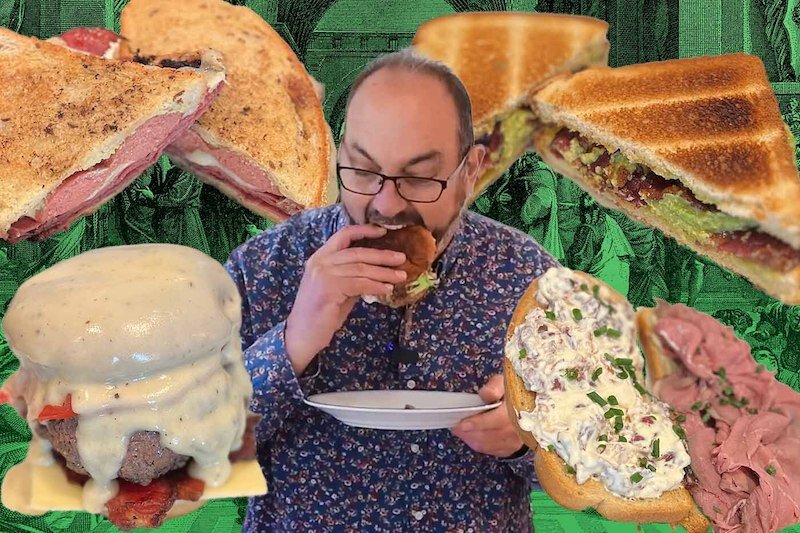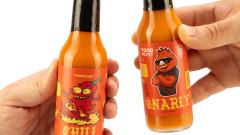This Man Is On A Quest To Recreate Sandwiches From Throughout History

Is there a culinary creation more perfect than the sandwich? It’s a simple concept that has sliced its way into the hearts, minds, and bellies of people worldwide. The idea was invented by John Montagu in 1762, who is appropriately nicknamed the 4th Earl of Sandwich. Like most things, it was created by accident. Montagu got hungry while playing cards one night and rather than leave the gaming table, he asked the server to bring him roast beef between two slices of bread. The rest is sandwich history.
History is, in fact, filled with thousands of sandwich inventions. Many have attempted to make the perfect sammie, and while most never attained the iconic status of a BLT, some of them are equally delicious. Barry Enderwick is a food historian and curious epicurean behind “Sandwiches of History,” a passion project about unearthing and sharing sandwiches from past decades. It all began in 2018 when a friend sent him a PDF of “The Up-To-Date Sandwich Book” of 1909, which contained 400 recipes for all sorts of sandwiches. Inspired to recreate and share the sandwiches on social media, Enderwick set off to begin his journey into the culinary past.
“My favorite sandwiches from The Up-To-Date Sandwich Book of 1909 are the simpler ones. Like the Olive and Caper Sandwich, Cucumber and Cream Cheese Sandwich, and the Honey and Banana Sandwich,” Enderwick says.
Since taking the first step, he’s made over 1,000 sandwich varieties, even some that pre-date 1909. Recreating sandwiches from the past is a fun way to learn about history. It unveils popular flavors and ingredients, shedding light on their significance. Take the BLT for example, it’s believed to have originated as a tea sandwich in rural Victorian England during the latter half of the 18th century, and didn’t become an American diner staple until after 1903.
“One observation I’ve made about sandwiches from the early 1900s is that they utilized small quantities of ingredients and often ground various fillings. My hypothesis regarding the latter is that grinding ingredients like ham, along with others, not only enhanced the sandwich’s appeal but also extended the use of meat,” Enderwick shares.
Enderwick’s journey began with The Up-To-Date Sandwich Book of 1909, but has since expanded to include all sorts of recipe books and pamphlets from history. “‘1,001 Sandwiches from 1936’ is amazing in that they have some tasty recipes and some odd ones. I mean, if you have 1,001 recipes in a book, they can’t all be home runs,” he says. When asked which country is sandwich king, he says that he finds Asian sandwiches most interesting. “Whether it’s the Menbosha from South Korea, the Tamago Sando from Japan, or the Banh Mi from Vietnam, the sandwiches from that part of the world are packed with well balanced deliciousness.”
Enderwick’s social media accounts feature a new sandwich recreation almost every day. Among the latest are the Nasturtium and Celery Sandwich (1908), comprising flower petals and mayonnaise on white bread, the Ham and Anchovy Sandwich (1928), and the Potato-Cabbage Sandwich (1917), a genuine working-class masterpiece.
When asked what his idea of the perfect sandwich is, Enderwick humbly offers, “I know this answer is deeply unsatisfying but the perfect sandwich is the one that fits your mood. I get asked ‘What’s your favorite sandwich?’ But here’s the thing, am I very hungry or just a little? Is it a hot day or cold day? Those factors and more contribute to what the perfect sandwich is. That being said, I do love a Reuben… or a Pan Bagnat… or a Banh Mi…”
Moving forward, Enderwick is in the final editing stages of a Sandwiches of History Cookbook with a tentative late October release. He hopes to create a pop-up event to promote the book throughout the United States. “I’d like folks who follow Sandwiches of History to take away how food has changed over time and also how to think about modifying not only sandwiches but all food to make it something they really enjoy,” he concludes.
Follow Barry Enderwick’s journey into the Sandwiches of History on Instagram, TikTok, or YouTube.






















